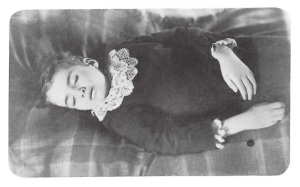Postmortem photograph of unidentified child. Harrison, Lock Heaven, Pa., ca. 1890-1910. Tinted gelatin silver print on cardboard mount, carte de visite. Courtesy, Center for Visual Communication, Mifflintown, Pa.
The enduring tradition of painted mortuary portraits precedes Nineteenth century mortuary photography. Jay Ruby writes, “The association of death and sleep is as old as Western culture itself. In classical Greece, the sons of the night were Hypnos, god of sleep, and his twin, Thanatos, god of death.” (1)
The denial of death was a pictorial convention that prevailed during the Nineteenth century. “People did not die. They went to sleep.” (2) The “last sleep” was a popular theme in mortuary photography because it beautified death by creating the illusion of sleep. With the high infant mortality rates during this time, mourning was a normal part of life. Memorialising the deceased was common and mortuary photographs were often displayed in the home.
A photograph retained the memory of the deceased and was also a lasting reminder that we have no power over death, a memento mori. The young boy (pictured above) is dressed in his Sunday best and it was probably the first and last time he was photographed. The photographer has adhered to the prevailing ideology of the day, and the boy appears to be sleeping. The photograph is a carte de visite, a small photograph that was relatively inexpensive to produce. The carte de visite was hugely popular and people would collect, trade or send them to loved ones. I cannot help asking whether his mother still carried him, even after his death, in her pocket.
References
1. J Ruby, Secure the Shadow: Death and Photography in America, Twelvetrees Press, 1990, p. 63.
2. ibid.
Image
J Ruby, Secure the Shadow: Death and Photography in America, Twelvetrees Press, 1990, p. 66.


Dear Sandra,
These acts of photography may have softened the blow of death with the sweet illusion of sleep that you so acutely point out. To look at a corpse is to brush with Freud’s ‘Uncanny’, so terrifying is their complete immobility, without the breath or pulse which we normally detect when someone is absolutely still in the depths of sleep (especially children, who can be so very still!). Make a photograph of death and these clues of life disappear and it is so easy to convince oneself that the subject sleeps. The converse idea that has taken hold through the writings of Sontag, Metz and Barthes is the ‘killing’ of the subject by the photograph. This is something that fascinates Rebecca Louise, a PhD candidate I supervise at Deakin, who is looking for artists who explore such ideas in self-portraits for inclusion in an exhibition she is curating…http://wp.me/p1ZU6J-8F…please spread the news!
Do you know of Margaret Gibson at Griffith and her research into this fascinating phenomenon? http://griffith.academia.edu/MargaretGibson
Regards,
James
hi James,
ty, once again for your comments.. i will most certainly look into your references.. Of course Freud, Sontag & Barthes are regulars on my reading list, there books are almost in tatters on my bookshelf, but Metz is a new scholar i will def. have a look at.
i will follow your links to Louise & Gibson, sounds fascinating..
so lovely of you, taking the time to share your knowledge.
With thanks,
S